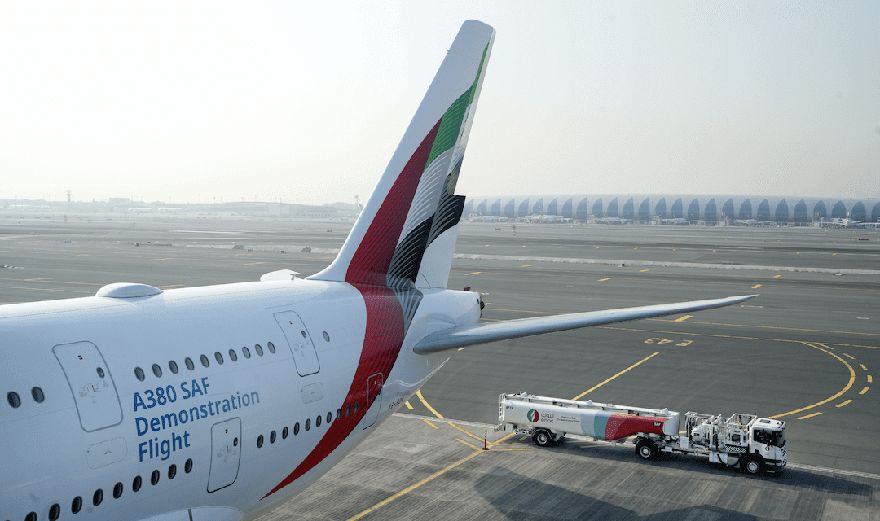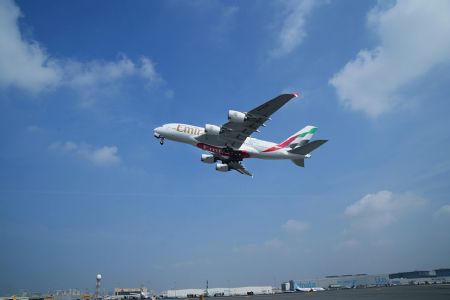 Airbus A380. Photo courtesy of Emirates
Airbus A380. Photo courtesy of EmiratesDubai-based
Emirates recently became the first airline to operate an Airbus A380, the world’s largest passenger airliner, on 100% sustainable aviation fuel (SAF). The jet, which is powered by four
Engine Alliance GP7200 engines, used 100% SAF in one of its four engines, another milestone in the industry’s growing momentum to bring standardisation, certification, and adoption of 100% SAF closer to reality. The use of SAF can reduce carbon emissions over the fuel’s life cycle when compared with conventional jet fuel.
The demonstration flight was the product of a partnership consisting of Airbus, Neste, Virent, and Engine Alliance, a 50-50 joint company between GE Aerospace and Pratt & Whitney. It took place amid the
Third International Civil Aviation Organisation (ICAO) Conference on Aviation and Alternative Fuels (CAAF/3), held recently in Dubai. CAAF is convened by the UN’s International Civil Aviation Organisation (ICAO).
This test flight also comes after Emirates flew the first demonstration flight using 100% SAF in the Middle East–Africa region earlier this year. On that flight, aboard a Boeing 777-300ER, SAF powered one of the two GE90 jet engines.
Aziz Koleilat, GE Aerospace vice president of global sales and marketing for the Middle East, Eastern Europe, and Turkey, said: “Innovation and collaboration are the keys to reaching ‘net zero’ carbon emissions by 2050, as this 100% SAF demonstration flight shows. All GE Aerospace and Engine Alliance engines can operate on approved SAF blends today, and through extensive research and testing, GE Aerospace is helping lead the approval and adoption of 100% SAF in the aviation industry.”
According to Gurhan Andac, GE Aerospace engineering fuels and fuel additives leader, GE Aerospace has been involved in SAF for more than 15 years, since efforts to test synthetic fuel began. In October, Andac appeared at the
Sustainable Aviation Futures North America Conference, where he said that even though SAF constitutes only 0.1% of jet fuel consumed worldwide, these alternative fuels — which have the same chemical composition as the jet fuel most commonly used today — are set to have their moment soon.

Almost 530,000 flights have operated on SAF blends since 2011, and there are now six airports regularly supplied with SAF, according to the
Air Transport Action Group (ATAG), a coalition focused on driving air transport toward ‘net zero’ emissions. This year an eighth SAF pathway — or set of conversion processes for the various SAF feedstocks — was certified, and seven more are being assessed over the coming two to five years.
An ATAG news release said: “Airlines, operators and corporate partners currently have around $45 billion in forward purchase agreements for SAF.” Up from $6 billion before the pandemic, and delivery of SAF to airlines increased by ten-fold from 2019 to 2022. The Association of Asia Pacific Airlines, meanwhile, committed to a minimum of 5% of their fuel being SAF by 2030 and ATAG reported:
“There are now 50 airlines representing over 40% of global air traffic committed to more than 5% of their own fuel use being SAF in 2030. Many have set a goal of 10% and some are up to 30% by 2030.”
ATAG executive director Haldane Dodd also underscored the importance of collaboration in the effort, saying there are three things needed to bring about an energy transition in aviation: “Government policy, to support supply and create certainty for demand; financing of the potentially $1.5 trillion in infrastructure capital needed to supply SAF at the scale required; and a serious effort by the traditional energy sector to shift their products from fossil to sustainable fuels.”
Mr Dodd said the industry’s decarbonisation strategy must also include hydrogen, more electric flight, and other emerging technologies, but: “Every piece of analysis shows that SAF is the most impactful way to cut aviation’s carbon emissions before 2050.”
GE Aerospace’s Mr Andac said in October: “SAF is not an R&D project we conduct on the side. It is in the field. We have over half a million flights in the aviation industry — it is out there, and we are flying.”